渭南市文化艺术中心,陕西,中国
渭南市文化艺术中心,陕西,中国
Weinan Culture and Art Center, Shaanxi, China, 2014
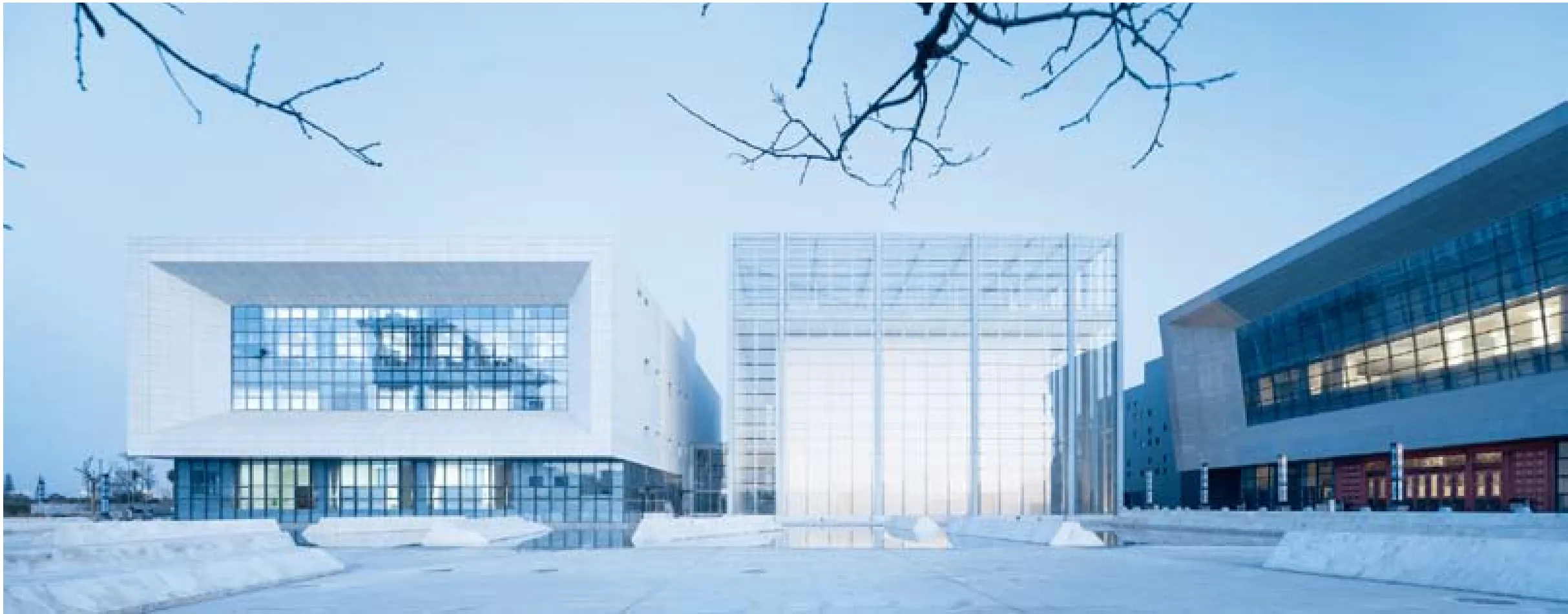
1 外景/Exterior view
渭南地处关中平原东部,以在渭水之南得名。渭南人文气息深厚,是《诗经》开篇之作《关雎》的诞生地,也是太史公司马迁的故乡。为实现建设秦晋豫黄河三角区区域中心城市的城市总体规划目标,作为提升城市活力和完善城市功能的重大举措之一,市政府做出在规划中的行政文化区新建文化艺术中心的决定。渭南市文化艺术中心包括大剧院(1200座)、一个多功能厅(非物质文化遗产展示传习中心)、影城和培训楼等内容,总建筑面积约3.4万m2。作为在地性创作系列研究之一,经历近5年的不懈努力渭南市文化艺术中心投入使用。在短暂地体验了“一朝归渭上,泛如不系舟”的适意之后,建筑师对追寻建筑在地性有了更多的思考。
由于城市的快速发展,基地原有村落已经因拆迁而销声匿迹,取而代之的是周边面孔陌生的高层办公楼和住宅小区。城市在快速发展的同时也丧失了原有的风貌。建筑策划之初就根植于这片土地进行认真解读,研究建筑的在地性问题。设计以非对称布局方式弱化主轴线的呆板,活跃建筑的群体感,3幢建筑各成方向,相互对话,共同营造文化的场所感。
渭南地处八百里秦川最宽阔的地带,唐朝诗人崔颢有“河山北枕秦关险,驿路西连汉畤平”的感慨。南部黄土台塬与洪积扇相间有“长捻原”之美称。南北边缘为石质山地,被诗仙李白咏为“西岳峥嵘何壮哉”的华山就在渭南华阴。当地村落大多就地取材,常用的材料有夯实的黄土、石材、烧制的青砖。艺术村落的组合就兼顾当地材质多样性的特点,每个单体的主材质各不相同。3座建筑的外墙材料分别采用关中传统的青砖、石材和玻璃幕墙,表面做了凸凹的变化,材质的鲜明对比产生强烈的视觉冲突,传统和时代的对话提升了建筑的场所感。立面上的斜线关系实际上是和文化行政中心区的大绿地肌理有所呼应,由墙面延伸下来和地面融合,与绿地景观形成一种逻辑和肌理关系。考虑到渭南属暖温带半湿润半干旱季风气候,夏季炎热多雨,设计在建筑突出部下方形成多个灰空间,可以遮荫避雨。同时在场地中央设置浅池收集雨水,每当晚风徐徐,建筑的倒影在水中摇曳多姿。关中人大多性情耿直,宁折不弯。尤其是秦腔高亢激昂和激烈碰撞,韩城行鼓的彪悍豪爽和执着陶醉,给了建筑创作以启发。建筑以长方盒子为基础进行变形,多个建筑形体之间相互碰撞,相互耦合。每个既是一个完整的单体,又有机组合成一个艺术村落。这样一种布局在增加城市空间趣味性的同时,具有浓郁的关中味道。
渭南皮影戏被列入国家第一批非物质文化遗产名录,是关中地区民风民俗的活化石,是最能代表渭南的戏曲形式,很自然地和大剧场功能形式发生化学反应。在当地原生的村落里,皮影往往是传统节庆的焦点和压轴节目之一,和村落生活融为一体。青砖,是当地最普遍使用的建筑材料。通过建筑师对材料的处理,青砖和型钢组合形成富有特色的建筑语汇。将整体长100m高22m的青砖墙体作为幕布,使用型钢作为笔墨,挥洒泼墨勾勒出抽象的皮影戏曲人物。在立面不同的区块利用型钢和青砖凸凹变化形成丰富的建筑表情。青砖根据高度和视角不同划分为3种规格,分别突出前面2cm、6cm和10cm,层层叠叠,玲珑绚丽。在阳光下随着时间的变化,砖的光影变化为建筑增添勃勃生气。整个建筑既有华阴老腔般的粗犷豪迈、雄浑奔放,建筑细部又有华县碗碗腔般的细腻雅致、婉转缠绵。南侧的立面在满足功能的前提下,开窗注重情绪和节奏控制。窗檐部分进行多重的叠涩处理,具有浓郁的地域特色。
文化艺术中心的大剧场是渭南市秦腔剧团的驻场剧场,在设计之初即和剧院专业人士就演出和运营等进行沟通。设计同时关注群众的日常性参与,为群众提供大剧场以外的各种文化活动场所,包括兼顾小型演出的多功能厅和面对城市绿地的开放式舞台。此外,根据前期对市场需求的调研,文化中心合理设置了集影院、展厅、艺术培训、纪念品销售、快餐、咖啡、音像书店、休闲茶廊等功能用房,文化艺术中心形成日常向市民开放和以商养文的良性运营格局,为城市中心注入了新的活力。□
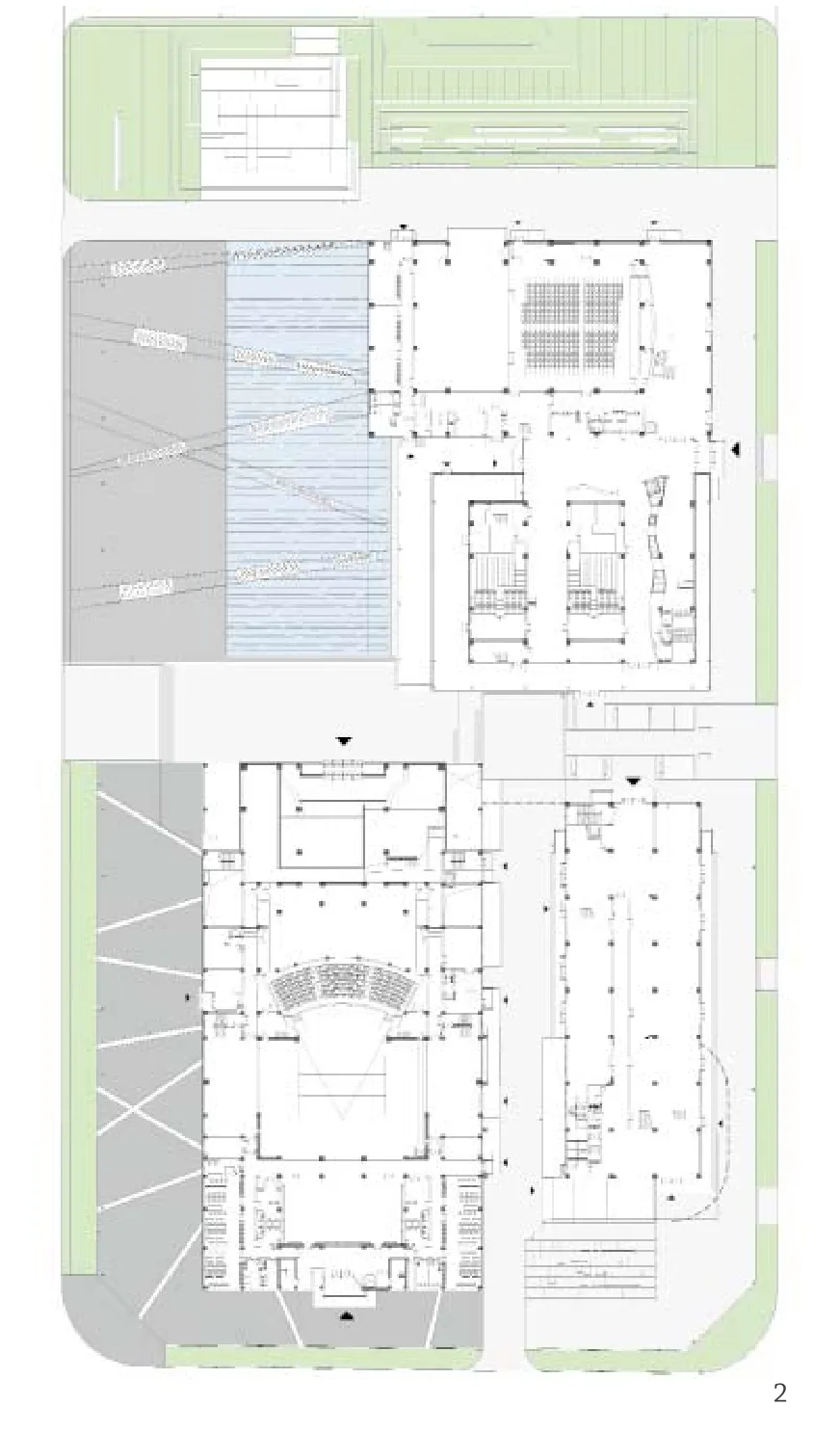
2 总平面/Site plan
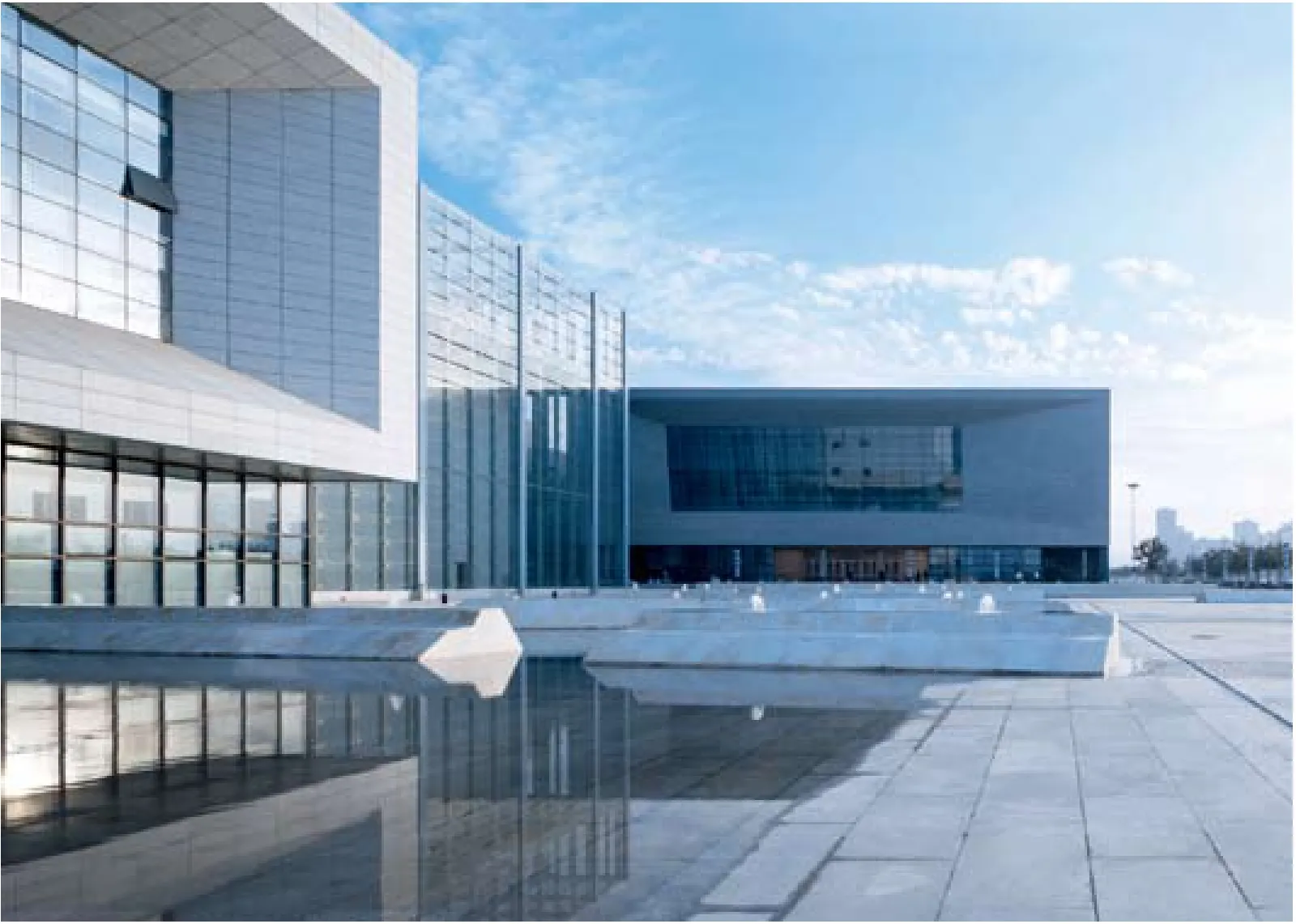
3 外景/Exterior view
项目信息/Credits and Data
项目负责人/Principal in Charge: 庄惟敏/ZHUANG Weimin
设计团队/Design Team: 庄惟敏,张维等/ZHUANG Weimin, ZHANG Wei, et al.
景观设计/Landscape Design: 李伦/LI Lun
场地面积/Site Area: 40,000m2
总建筑面积/Total Floor Area: 33,942m2
建筑高度/Height: 24m
设计时间/Design Period: 2009.7-2010.9
竣工时间/Completion: 2014.8
摄影/Photos: 姚力/YAO Li
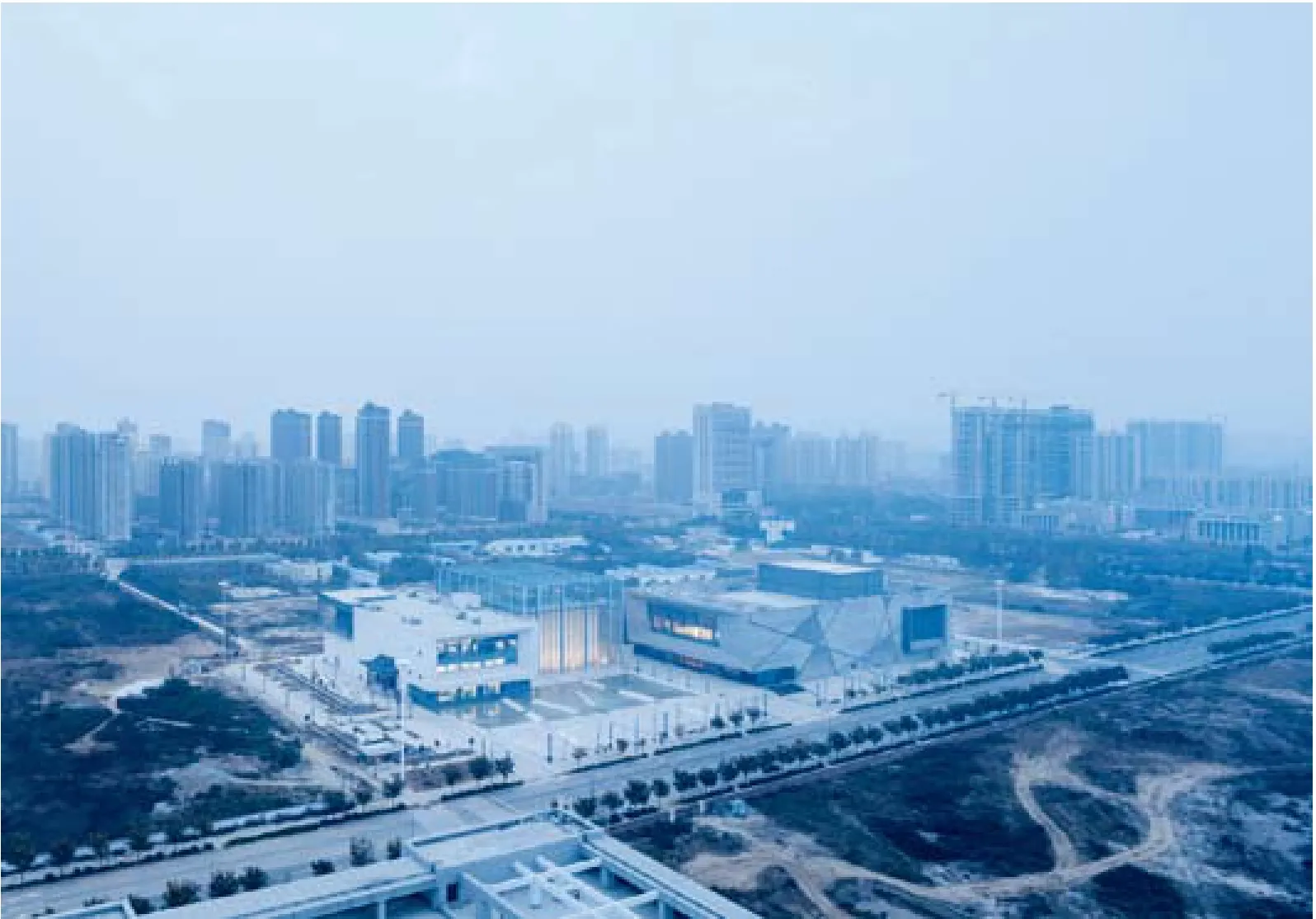
4 鸟瞰全景/Bird's eye view

5 外景/Exterior view

6.7 内景/Interior views
Weinan City gains its name by being situated on the south of Wei River. It is the place where ancient poem "Guanju" praises. It is also the hometown of the great author of "Shih Chi (the historical record)". In order to raise city vitality and fulfill the aim of city's master plan to create a regional central city among the Qin-Jin-Yu Yellow River Delta area, the local municipal government decided to construct a cultural center in the new administration district. the culture and art center includes a large theater (1200 seats), a multipurpose hall (intangible cultural heritage learning center), a movie theater and training center. the total floor area is 34,000 m2. the project reflects the architect's continuous research on genius loci, and after 5 years of design and construction it came into use. It inspired the architect a poetic sense of being at ease and feel free, and made the architect to think more on this subject.
As the city grow, original cottages on the site has vanished and being replaced by tall concrete buildings. The city has lost its character on the process of development. The start point of architectural planning is to interpret the site and the spirit of the place. An unsymmetrical layout was chosen to weaken the stiffness associate with main axis and to vitalize the building cluster. three buildings heading different directions, looks like they are talking to each other, jointly create a sense of place.
The vast Qinchuan embraced Weinan at its widest part. Landscape on the south is named "Changnian plateau" with pluvial fan and loess plateau crossing each other. Rocky mountains lies on the edge of south and north. Among them is the famous Huashan Mountain in Huayin. From ancient times poetries have praised its steepness. Most of the building materials are found local, the most common ones are loess, stone and gray brick. Different traditional materials of Guanzhong area, namely grey brick, stone and glass, are chosen to be the main materials for different buildings. The effect is a strong visual comparison between past and modern, which embodies a sense of place. The diagonal patterns on facade are correlates to the landscape, continuing from the wall to the ground, and establish a logic and context with the landscape. To suit with local climate, part of the building stretching out on top and forms big cantilever, which creates gray space for rain shelter. Landscaped ponds are used to collect rain water and change microclimate, reflections of the building are also shown here. the straightforward characteristic of Guanzhong people and their art forms such as Qinqiang and Hancheng Drum give architect the inspiration to use rectangular boxes as basic building mass. Each mass is a complete entity itself, and together they form an interesting urban space, the art village, which has a strong expression of local features..
Weinan shadow play has been enlisted on the first national intangible cultural heritage, it is considered the living fossil of Guanzhong culture and folk art, and is a great representative of Weinan opera. there are natural connections between shadow play and the form of a theatre. In the original villages of Guanzhong area, Shadow play is always the finale of celebration show for holidays and big events. As a matter of fact, shadow play is part of the country life. Gray brick is a widely used local material. The architect use both grey brick and profile steel to form a unique language of facade design. A wall of grey brick was built to serve as the screen, which is 100m long and 22m tall. Profile steel was applied on the wall in a way like brush and ink to mimic abstract shadow play figures. Various expressions are created in different sectors on the wall as bricks sticking out with different dimensions. Each brick convex out either 2cm, 6cm or 10cm, according to different elevation and viewpoints. the bricks lie tier upon tier, and the sunshine and shadows would shift when time changes, this makes the wall a dramatic view. the whole building is bold and vigorous as the Huayin Old Tune, while the details are exquisite and graceful as the Wanwan Tune of Hua County. Windows are carefully proportioned on the south facade with certain rhyme. And layers of brick Corbel along the sunblind represent a typical vernacular architectural language.
One of the main function of the Weinan theater is to serve as the Qinqiang troupe's home court , so the design team visited the artists and considered their need for performance and operation from the beginning. The project also focus on public participation and provide multiuse hall and outdoor stage. It consists many amenities such as training, souvenir, café and teahouse according to a study on market demand. Finally the cultural center becomes an attraction to the public and benefits from a successful commercial-cultural synergy.□
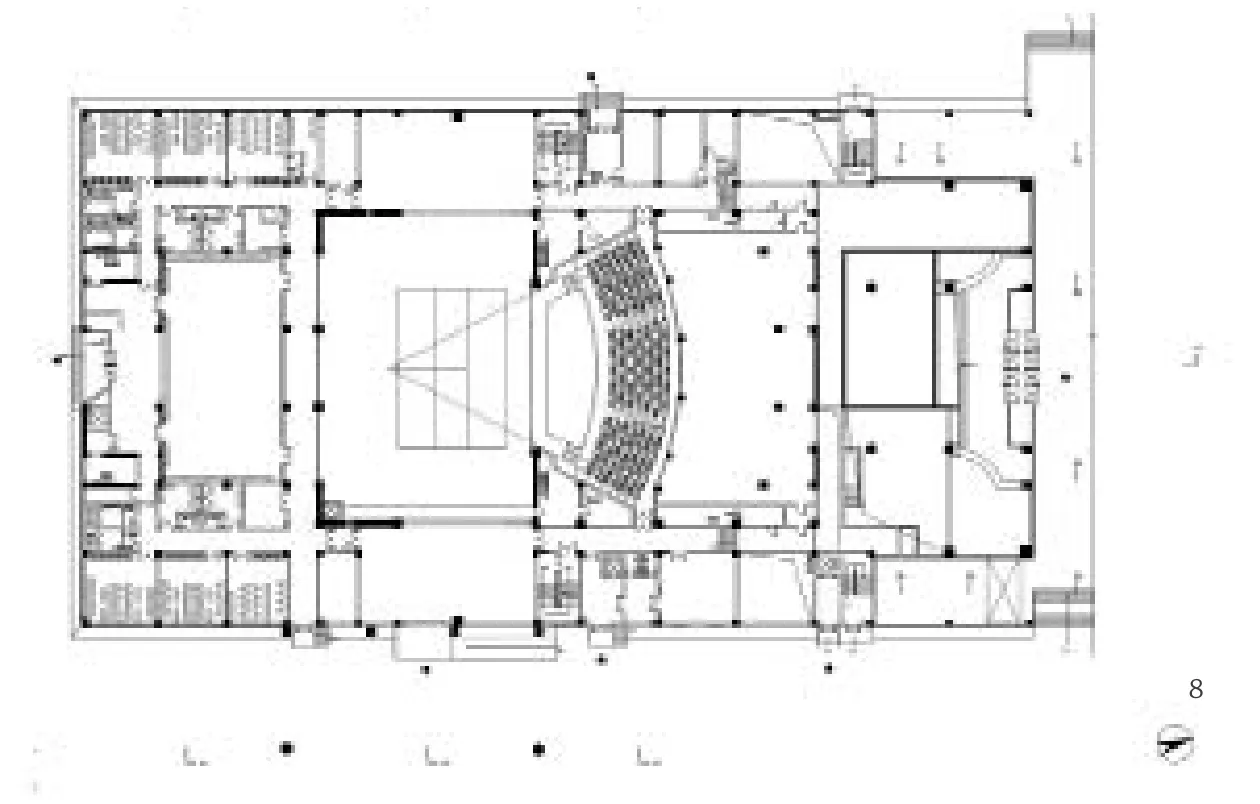
8 首层平面/Floor 0 plan
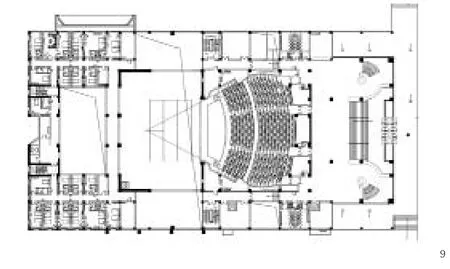
9 二层平面/Floor 1 plan

10.11 剖面/Sections
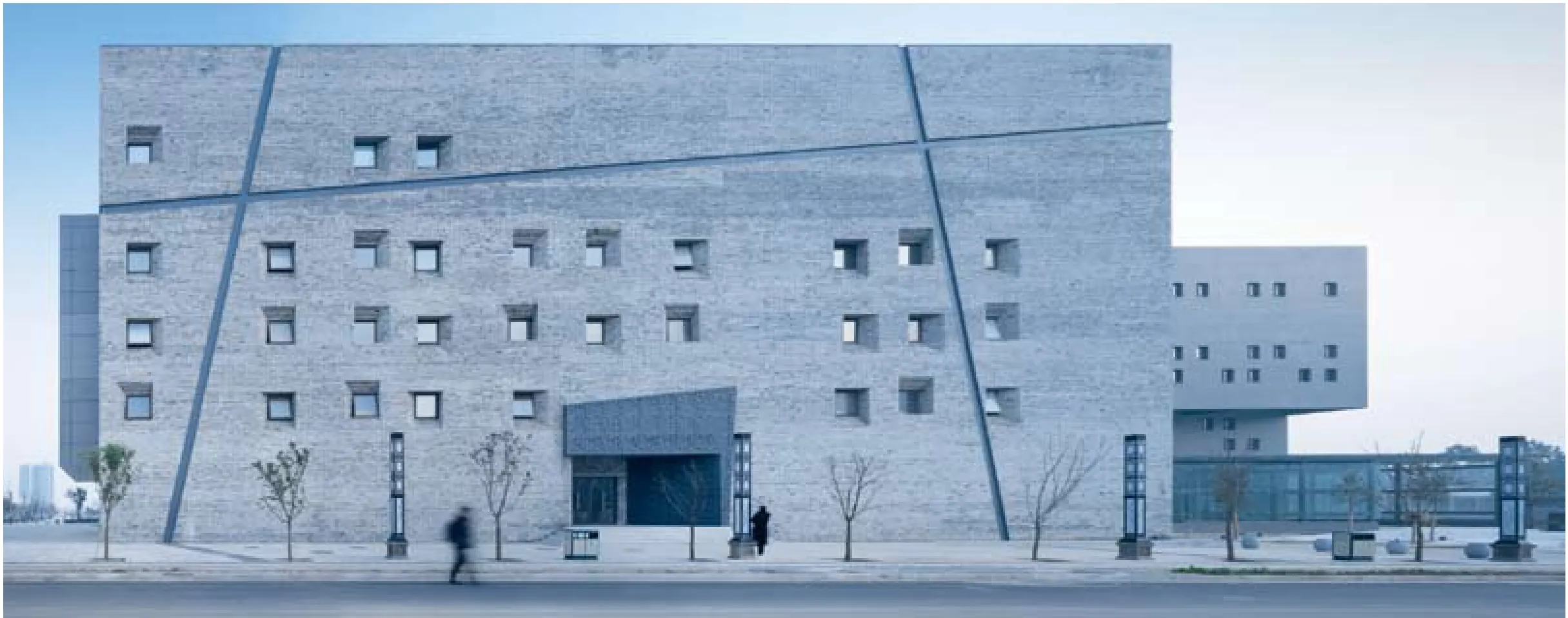
12 立面/Facade
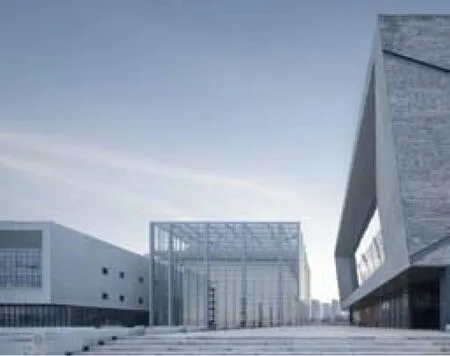
13 外景/Exterior view
评论
屈培青:秦腔清唱
在国内城市中,大剧院似乎已经成为了一个城市树立形象不可或缺的符号,我们也已经习惯了城市中这些巨大的建筑。从渭南文化艺术中心总体布局上,建筑师把当地业主最初设想的一个巨大体量的建筑综合体,按大小剧场功能划分成相互呼应的三组建筑构成品字型布局,紧凑的功能布置将尽可能多的空间留给城市,形成开放式院落空间,共同营造文化的场所感。通常而言,这种空间上的呼应就足够了,但对于陕西关中这样一个有着深厚文化底蕴的地方,文脉的呼应也是不可缺少的。设计中有三个很有内涵的特点:
一是面对城市绿地外挑开放式舞台。户外搭台唱戏是关中民间传统的表演形式,也是老百姓日常不可缺少的文化娱乐活动。而该舞台移植了关中传统建筑的戏楼,显示出设计对于文化传承的有意强调,传统和时代的对话提升了建筑的场所感。
二是将传统建筑的文脉、符号、材料、肌理用新的建筑语言,整合到现代建筑之中,采用简约的手法与传统建筑精神共存,将关中民居中青砖墙的厚重、白墙面的朴素、木材纹理的清晰,与现代建筑中玻璃的清澈透明、金属材料的精美有机结合,建筑在保留了传统建筑材料的同时,赋予现代新材料的肌理,在色彩上表达出传统民居黑、灰、白的基本色调,在建筑构架体系中营造人文气息。
三是从粗犷豪迈、雄浑奔放的地域音乐中获得建筑创作的灵感。建筑表皮设计截取皮影戏的文化记忆,将其附着于建筑界面,并且叠合剪影,为建筑界面的创造提供多种可能性。通过青砖这种当地传统材料,加上民间花砖墙叠合砌筑的手工艺方式,建筑师通过砖的肌理,将青砖和型钢组合形成富有特色的建筑语汇。将整体100m长、22m高的青砖墙体作为幕布,使用型钢作为笔墨,挥洒泼墨勾勒出粗犷豪迈的丰富立面效果,也暗合了传统戏剧中的光影手法,使建筑更加耐人寻味。所有这些处理,都使得建筑在“大”的限制条件下,尽量寻找到“小”,也就是更加亲近于人的建筑特质。这种粗犷的建筑外形和细腻的处理,就像是洪亮的秦腔中一抹悠扬的清唱。
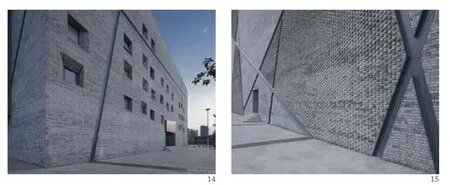

14-16 剧院立面局部/theater's façade detail
Comments
QU Peiqing: Oratorio in Shaanxi Opera
A grand theater can often be seen as a vital symbol for a Chinese city's image and the residents of these cities have become familiar with such huge contractions. the first idea of the local client for the Weinan Culture and Art Center was to make a huge building complex. Instead, architects divided the complex into a group of buildings with a T shape layout. It consists of three parts according to different functions. this compact layout left maximum space available for public use and the open courtyard-style space created a sense of cultural identity. Generally speaking, a T-shape layout that connects each part is good enough to create a space. However, this was not enough for the rich culture and history of Guanzhong region in Shaanxi Province. To pay homage to its location, the Shaanxi culture was interwoven into the design of the Weinan Culture and Art Center. there are three ways the architect showcases the context in his design:
Firstly, there is a projecting open-air stage facing the city's green area. Opera on an open-air stage is traditional in Guanzhong folk performance and is an important entertainment activity for the locals as well. the stage maintains traditional Guanzhong opera house design. It emphasizes the purpose of cultural inheritance and a dialogue between tradition and the contemporary thoughts. these help to build a sense of local spirit.
Secondly, traditional architectural contexts, symbols, materials and textures have been utilized in the modern architecture of the center. Architects of the Weinan Culture and Art Center combined elements of thick Grey-brick wall, plain white wall and clear wood texture – which comes from the Guangzhong architectural convention – with crystal glasses and refined metal materials from modern styles – which is currently in use. this simple approach which respected the traditional architectural spirit allowed the center to maintain the traditional material of the region yet supplemented with a touch of modernity. the traditional basic colors of black, grey and white in buildings of Guanzhong foster a positive atmosphere of the region.
Thirdly, the design of the Weinan Culture and Art Center was inspired by passionate regional music while its facade design was inspired by shadow plays. This method, a kind of silhouette overlaying, provided multiple possibilities for the facade design. Architects used the traditional material of grey brick and an overlaid bricklaying method of tiled walling to make a stylish exterior consisting of brick texture, grey brick and profile steel. Employing a 100-meter long and 22-meter tall grey brick wall as its screen while profile steel served as brushes and inks, architects pictured a bold facade design with the elements of light and shadow from traditional opera, which made the Center's design more intriguing. All these elements allowed tiny details to be highlighted in the huge Weinan Culture and Art Center project. the decision to include such details in the grand design of the building endears it to all who visit. the refined details , in contrast with the bold design of the Center , just like an oratorio in Shaanxi opera.(English translation by Dandan WANG)
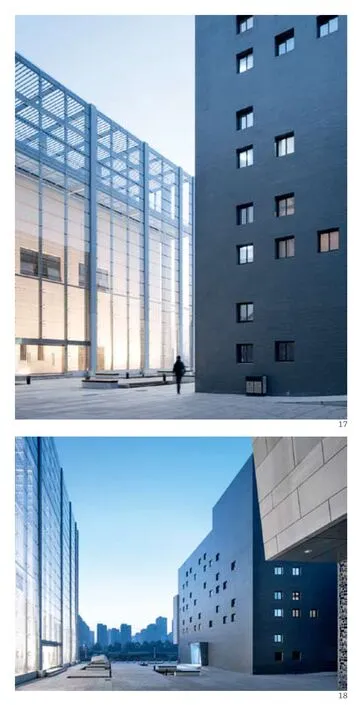
17.18 外景/Exterior views

